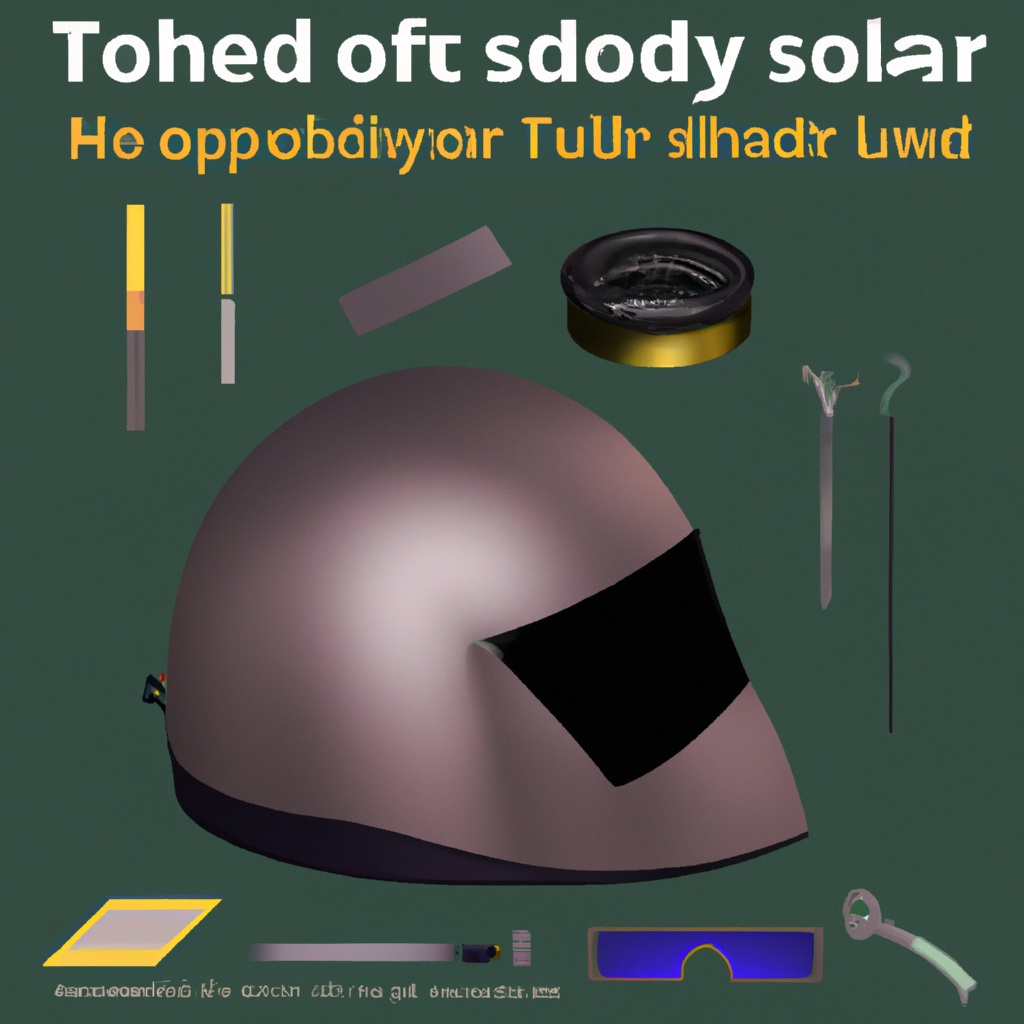Welding helmets are an essential tool for any welder. It is important to choose the right helmet that has the right shade of darkness. The shade of the helmet will determine how much protection you will have from the intense ultraviolet and infrared radiation generated by the welding arc. Knowing what shade your welding helmet is and whether or not it adequately protects you from the radiation is essential. In this article, we will explore the different shades of welding helmets and how to determine which shade is right for you. From the basic principles of welding helmet shade to the major considerations you should make when selecting a welding helmet, read on to find out everything you need to know about selecting the right shade for your welding helmet.

What is the purpose of welding helmets?
Welding helmets are essential safety gear for welders, protecting their eyes and face from the intense ultraviolet and infrared radiation created by the welding process. Welding helmets also protect from sparks and metal splatter. Here are some of the key benefits of wearing a welding helmet:
- Provides protection from harmful UV and IR radiation
- Shields the eyes and face from sparks and metal splatter
- Enables comfortable welding for longer periods of time
- Improves welding accuracy and productivity
Most welding helmets feature a darkened viewing lens that blocks out the intense light created by the welding process. The darkness level of the lens is referred to as the shade. Different welding processes require different shade levels for optimal protection. So, how do you know what shade your welding helmet is?
You can usually find the shade level of your welding helmet written on the inside of the helmet, near the lens. The shade level is usually written as a number, such as 8-13, 10-13, 11-13, etc. The higher the number, the darker the shade. For example, an 8-13 shade level is lighter than a 10-13 shade level.
What is the importance of shade numbers?
Shade numbers are an important factor to consider when selecting a welding helmet. Shade numbers refer to the darkness of the lens used in the helmet. The shade number is usually indicated on the lens and the helmet itself. A higher shade number indicates a darker lens and a lower shade number indicates a lighter lens.
A welding helmet with a higher shade number is better for most welding applications. The higher shade number provides greater protection from harmful UV and infrared rays that are emitted during welding. A higher shade number also reduces glare and improves visibility. It is important to select the correct shade number to ensure the highest level of protection and visibility.
The shade number of a welding helmet can be determined by reading the information printed on the helmet or on the lens. In some cases, the helmet may also come with a shade number chart that provides a reference for selecting the correct shade. It is important to ensure that the correct shade number is selected for each welding application.
What factors should I consider when selecting a welding helmet?
When selecting a welding helmet, there are a few key factors to consider. These include:
- Safety rating: Look for a helmet with a high safety rating to ensure optimal protection.
- Lens type: Choose between auto-darkening, passive, and flip-front lenses based on the type of welding you will be doing.
- Weight and comfort: Make sure the helmet is lightweight and comfortable to wear for extended periods of time.
- Shade level: The shade level of the helmet determines how much light is blocked from your eyes when welding. It is important to determine the shade level you need for the type of welding you will be doing.
To determine what shade level you need for your welding helmet, consult the American Welding Society (AWS) for the recommended shade level for the type of welding you will be doing.
What are the most commonly used shade numbers?
The most commonly used shade numbers for welding helmets range from #8 to #13. Here is a breakdown of the most common numbers:
- #8: Used for low-amp welding (less than 60 amps).
- #9-#10: Used for low-amp welding (60-100 amps).
- #11: Used for medium-amp welding (101-160 amps).
- #12: Used for medium-amp welding (161-200 amps).
- #13: Used for high-amp welding (greater than 200 amps).
To determine the shade number of your welding helmet, check the label on the helmet. It should indicate the helmet’s shade number. If you’re unable to find the number on the label, contact the manufacturer or consult your welding manual.
What is the difference between auto-darkening and non-auto-darkening helmets?
Auto-darkening welding helmets are designed to automatically adjust the shade of the lens to the appropriate shade for the welding task at hand. Non-auto-darkening helmets require the welder to manually adjust the shade of the helmet lens.
Here are the key differences between auto-darkening and non-auto-darkening helmets:
- Auto-darkening helmets are designed to be more convenient and time saving as they automatically adjust to the appropriate shade for the welding task.
- Non-auto-darkening helmets require the welder to manually adjust the shade of the lens.
- Auto-darkening helmets provide better protection from UV and infrared light.
- Non-auto-darkening helmets typically provide less protection from UV and infrared light.
- Auto-darkening helmets usually cost more than non-auto-darkening helmets.
To find out what shade your welding helmet is, you can consult the manual that came with the helmet or contact the manufacturer. Many welding helmets also have a label indicating the minimum and maximum shade level.
What are the safety features of a welding helmet?
A welding helmet is a critical piece of personal protective equipment (PPE) for welders. It protects the eyes, face, and neck from the intense light, sparks, and heat generated by welding. To ensure maximum protection, it is important to choose the right welding helmet with the right safety features.
Most welding helmets come with the following safety features:
- Auto-Darkening Filter (ADF) – This feature automatically adjusts the shade of the lens to protect the eyes from the intense light of the welding arc.
- Ultraviolet and Infrared Protection – The lens of the helmet should provide protection against both ultraviolet and infrared radiation.
- Grind Mode – Most welding helmets have a grind mode that allows the welder to switch from welding to grinding without having to remove the helmet.
- High-Quality Headgear – The headgear of the helmet should be adjustable and comfortable as it will be worn for long periods of time.
To know what shade your welding helmet is, you can refer to the manufacturer’s instructions. Most helmets have a number written on the lens, which indicates the shade. The higher the number, the darker the shade.
What is the correct shade number for my welding helmet?
When it comes to welding helmets, the shade number determines the amount of protection the helmet provides. A higher number means more protection from the intense light and infrared radiation produced during welding. Knowing what shade your welding helmet is can help you select the right type of welding helmet for your needs.
Here are some tips to help you determine what shade your welding helmet is:
- Check the packaging for the helmet. Many helmets will have the shade number printed on the packaging.
- Check the user manual that came with the helmet. The shade number will be included in the user manual.
- Look for a sticker or label on the helmet itself. The shade number should be clearly marked.
- Consult the manufacturer’s website. You may be able to find the shade number listed on the website.
In general, the best shade number for a welding helmet is around 80, but it can range from 8 to 120 depending on your needs. Be sure to select a helmet that is appropriate for the type of welding you are doing. If you are unsure of the shade number, you should consult a professional or the manufacturer for more information.
How do I determine the correct shade number for my welding helmet?
Determining the correct shade number for your welding helmet is essential for ensuring your safety while welding. Here are the steps you should take to determine the correct shade number for your welding helmet:
- Consult your welding machine’s manual to determine the recommended shade number for the type of welding you are performing.
- Measure the arc length of your welding machine and select a welding helmet with a shade number that is appropriate for that arc length.
- Consider the type of welding you are doing and select a helmet with a shade number that is appropriate for that type of welding.
- Check the American Welding Society’s (AWS) recommended shade numbers for the type of welding you are performing.
- Check the safety regulations of your workplace and select a helmet with a shade number that meets or exceeds these regulations.
By following these steps you can be sure that you have selected a welding helmet with the correct shade number for your particular welding application.
How can I test the shade number of my welding helmet?
There are several ways to test the shade number of your welding helmet. Here are a few:
- Check your welding helmet’s packaging or instructions. Many welding helmets will have a label specifying the shade number.
- You can use a welding shade light meter to test the shade number of your welding helmet. These devices are available at hardware stores or welding supply shops.
- If you are welding, you can do a simple test by turning on your welding machine and holding the helmet up to it. If the shade number is correct, you should be able to see the welding arc through the helmet.
- Finally, you can ask an experienced welder. They will be able to tell you the shade number of your welding helmet.
Knowing the exact shade number of your welding helmet is important, as it will determine the amount of protection it provides. The shade number should be between 8 and 12, depending on the type of welding you are doing.
How can I adjust the shade number of my welding helmet?
Adjusting the shade number of your welding helmet is an important part of safety when welding. Here are the steps to follow in order to adjust the shade number of your welding helmet:
- Know what shade your welding helmet is. There is usually a number on the outside of the helmet that indicates the shade number. If you do not know the shade number, you can purchase a shade chart that will help you determine the correct shade.
- Turn the adjustment knob on your welding helmet to the desired shade number. This knob is usually located on the outside of the helmet, just above the visor.
- Adjust the lens on the inside of the helmet to the desired shade number. This will require you to open the helmet and adjust the lens.
- Test the shade number on your welding helmet to ensure it is the correct shade. You can do this by looking through the helmet while welding and ensuring the shade is not too dark or too light.
Following these steps will help you adjust the shade number of your welding helmet. Remember, the desired shade number should be around 80 (maximum 120).



